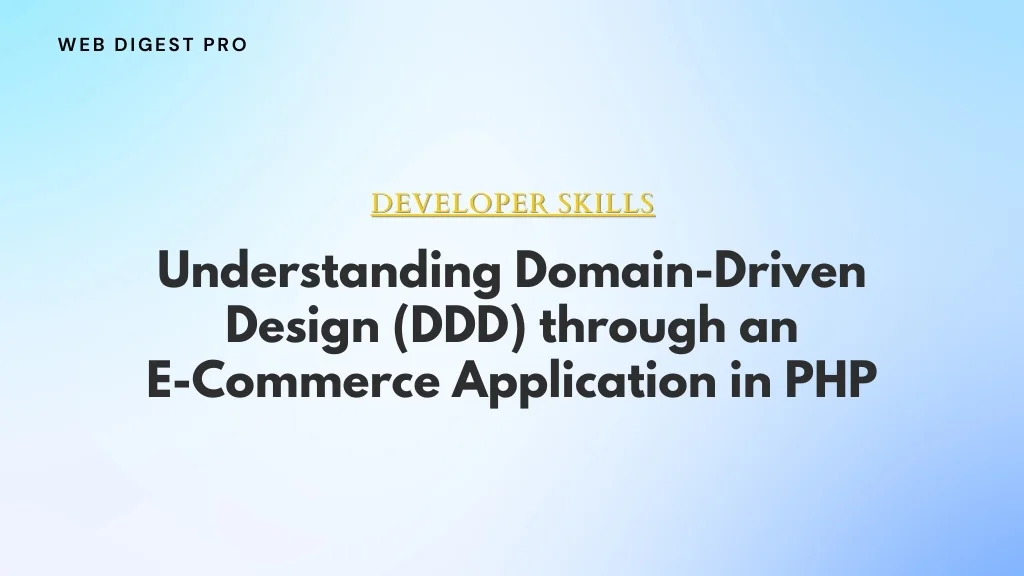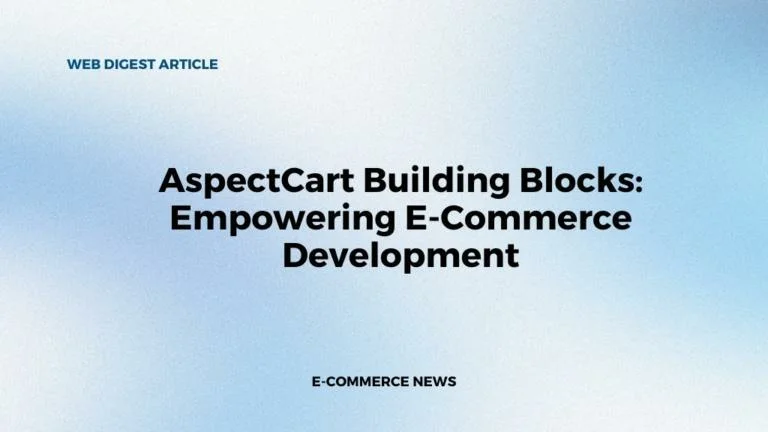In software architecture and design, Domain-Driven Design (DDD) is a powerful methodology for building scalable, maintainable, and flexible applications. By integrating the expertise of technical professionals with insights from domain experts, DDD fosters a comprehensive understanding of the domain, leading to more effective software design.
In this article, we will look into some basic concepts of DDD, give a detailed structure that an e-commerce application should take, and provide a PHP example that illustrates these concepts.
What is Domain-Driven Design (DDD)?
Domain-driven design is a comprehensive approach to software design that emphasizes the core business domain and recognizes its inherent complexities. The real heart of DDD is in re-aligning the purely technical aspects of software development to the subtleties of the business for which it is being created. This would ensure alignment so the software solutions meet functional requirements effectively, and provide appropriate solutions to the real business need.
Focus on the Domain
One of the key premises of DDD is an insistence on deep understanding of the business domain. In this respect, continuous collaboration with domain experts is needed. Domain experts are people with extensive knowledge about business processes, problems, and needs. In this way, the development teams can capture the requirements precisely without falling into assumptions and misinterpretations through open communication and collaboration. This domain focus ensures that the developed software is relevant, will be effective, and solves business problems.
Ubiquitous Language
To support this effective communication, DDD advocates the use of a ubiquitous language. The idea behind this comes with the development of common vocabularies understood by technical and non-technical stakeholders. By using a common language, developers and domain experts communicate requirements, design decisions, and features without ambiguities. This ubiquitous language bridges various disciplines and puts everybody in the project on the same page. Misconceptions are minimized, and that alone greatly increases the chances of developing software that matches what a business wants.
Bounded Contexts
In big projects, complexity can sometimes get out of hand. DDD approaches this with the concept of bounded contexts. A bounded context defines the scope within which a certain model applies. That is how development teams break down a huge application into smaller independent contexts so that the complexities can be isolated from each other and form a discrete model that would apply within their chosen context. In every bounded context, the interpretation of domain language takes place in its own way because, within this context, all terminologies and concepts must relate to each other. The separation keeps boundaries clearer and is easier to maintain changes and adapt to evolving business requirements without affecting other portions of the application.
Entities and Value Objects
One of the major things regarding DDD is distinguishing between entities and value objects. Entities are objects that represent an identity; their identity remains constant through time, while their attributes change. This means that the identity is invariant-for example, a user account can change its name, e-mail address, or preferences over time, but it is the same account because it has an invariant identifier. In contrast, a value object does not have any inherent identity and its identity is determined only by a combination of its attributes. They are always immutable since changes to an already existing object are realized by creating a new instance, instead of changing the state of the current one. This makes it easier for the developers to model the domain accurately and capture the transient or permanent features of the business correctly inside the software.
Repositories and Services
Also, DDD introduces the concepts of repository and service to structure the application effectively. The Repositories provide a data access abstraction layer that will enable the developer to use data sources without exposing the underlying complexities. They encapsulate the logic needed to retrieve and persist entities in a clean interface to be used by other parts of the application.
Services, in turn, encapsulate business logic and provide orchestration of operations across different entities and repositories. They implement use cases and guarantee that the application behaves exactly as intended. DDD therefore is a way of organizing business logic in such a manner that the codebase becomes modular and easy to deal with, and each service is independently evolving while continuing to collaborate, implementing overarching business goals.
Why Use DDD for E-Commerce Applications?
The adoption of DDD in e-commerce applications comes with immense benefits while responding to problems specific to the e-commerce domain. While companies wrestle with the intricacies of commerce being taken online, DDD offers a sound framework toward the development of superior and efficient software solutions. In this section, we shall discuss some key reasons why DDD turns out to be quite apt for e-commerce applications.
Complex Business Logic
E-commerce applications naturally have a lot of intricate business rules and workflows. Examples could include pricing strategies, the management of inventory, the authentication of users, the processing of payments, and the fulfillment of orders-all of which may have detailed logics that are usually laboriously maintained in an effort to create a seamless user experience.
DDD helps deal with this complexity by breaking it down into smaller, more cohesive pieces. By focusing on the core domain, the development teams can then isolate pockets of complexity and build models that accurately represent the business requirements. Such modularization allows developers to address individual components in isolation without the significant cognitive load that comes with trying to understand the whole application at once. As a result, teams can come up with solutions that are easier not only to implement but also in tune with business goals.
Scalability
As e-commerce businesses grow, the requirements of their software also evolve, and in most cases, it means rapid adjustments to accommodate increasing traffic, more features, or new market demands. DDD is particularly suited to this context because its modular approach lets developers adapt and scale applications with the least disturbance possible.
Scalability can thus be achieved through bounded contexts by organizing the application into separate contexts wherein teams will be able to work independently on scaling specific parts of the system. For instance, if the product catalog needs to grow with more stock, developers can enhance that bounded context without touching other areas like the user management or order processing systems. This flexibility is in demand by businesses wanting to stay atop market changes and consumer expectations. Thanks to DDD, this architecture will evolve with your business, ensuring the application stays responsive to new challenges.
Testability
Making your software reliable and bug-free is a must in today’s fast-changing e-commerce environment. DDD enhances testability through the emphasis on clear boundaries and contracts within the application. Every component will have a well-defined responsibility: an entity might or might not maintain its life cycle, a value object may or may not define the rules to measure something, and a repository defined how the data is accessed while a service defines an action. This makes it easier to isolate and test parts of the system.
With DDD, unit testing is easier because the developers have to consider only chosen functionalities inside services or entities without understanding the whole application context. The fact that DDD has a modular architecture provides great integration testing because teams can verify that various components will interact with each other properly. Because DDD provides testability, code quality increases and teams can speed up the development to release robust e-commerce solutions much faster.
Maintainability
Growth and evolution of e-commerce applications mean that maintainability is turning to be more and more important. DDD enhances the maintainability of the codebase thanks to an organization system based on the capabilities of the business, instead of on technical issues. In this respect, developers are driven toward reasoning at the level of the business domain, making an intuitive structure in the way stakeholders perceive the system.
DDD ensures separation of concerns, so that changes, for instance, in business rules on order processing do not accidentally affect other unrelated areas such as user authentication. This encapsulates the changes and reduces bugs from updates and feature additions. As time progresses, changing codebases offer teams a way of adding new features or refactoring existing ones with full confidence that underlying architecture supports both maintainability and adaptability.
DDD Structure for an E-Commerce Application
In this section, we will outline the DDD structure for an example e-commerce application, including key components such as entities, value objects, repositories, and application services.
1. Domain Layer
The domain layer is the heart of the application. It contains the core business logic, entities, value objects, and domain services.
Entities
- User: Represents a customer in the system.
- Product: Represents a product available for sale.
- Order: Represents a customer order, which may contain multiple products.
Value Objects
- Money: Represents a monetary value with an amount and currency.
- Address: Represents a physical address.
Example Entities and Value Objects
namespace Domain\Model\Entities;
class User {
private int $id;
private string $name;
private string $email;
private Address $address;
public function __construct(int $id, string $name, string $email, Address $address) {
$this->id = $id;
$this->name = $name;
$this->email = $email;
$this->address = $address;
}
public function getId(): int {
return $this->id;
}
// Additional getters and methods...
}
class Product {
private int $id;
private string $name;
private Money $price;
private int $stock;
public function __construct(int $id, string $name, Money $price, int $stock) {
$this->id = $id;
$this->name = $name;
$this->price = $price;
$this->stock = $stock;
}
public function getId(): int {
return $this->id;
}
// Additional getters and methods...
}
class Order {
private int $id;
private User $user;
private array $products = []; // Array of products with quantities
public function __construct(int $id, User $user) {
$this->id = $id;
$this->user = $user;
}
public function addProduct(Product $product, int $quantity): void {
$this->products[] = ['product' => $product, 'quantity' => $quantity];
}
public function getId(): int {
return $this->id;
}
// Additional methods to manage the order...
}
class Money {
private float $amount;
private string $currency;
public function __construct(float $amount, string $currency) {
$this->amount = $amount;
$this->currency = $currency;
}
public function getAmount(): float {
return $this->amount;
}
public function getCurrency(): string {
return $this->currency;
}
}
class Address {
private string $street;
private string $city;
private string $country;
private string $zipCode;
public function __construct(string $street, string $city, string $country, string $zipCode) {
$this->street = $street;
$this->city = $city;
$this->country = $country;
$this->zipCode = $zipCode;
}
// Additional getters...
}2. Repository Interfaces
Repositories provide an interface for data access, ensuring the application layer can interact with the domain without knowing about the underlying data source.
Example Repository Interfaces
namespace Domain\Repositories;
use Domain\Model\Entities\Order;
interface OrderRepository {
public function save(Order $order): void;
public function findById(int $id): ?Order;
public function findAll(): array;
public function delete(int $id): void;
}3. Application Services
Application services orchestrate the application’s use cases by coordinating entities, repositories, and other services. They handle business logic and ensure that operations are executed in the correct order.
Example Application Services
namespace Application\Services;
use Domain\Repositories\OrderRepository;
use Domain\Repositories\ProductRepository;
use Domain\Repositories\UserRepository;
use Domain\Model\Entities\Order;
use Domain\Model\Entities\Product;
use Domain\Model\Entities\User;
class OrderService {
private OrderRepository $orderRepository;
private ProductRepository $productRepository;
private UserRepository $userRepository;
public function __construct(OrderRepository $orderRepository, ProductRepository $productRepository, UserRepository $userRepository) {
$this->orderRepository = $orderRepository;
$this->productRepository = $productRepository;
$this->userRepository = $userRepository;
}
public function createOrder(int $userId, array $productData): Order {
$user = $this->userRepository->findById($userId);
if (!$user) {
throw new \InvalidArgumentException("User not found.");
}
$order = new Order(rand(1, 1000), $user); // Generate a random order ID
foreach ($productData as $data) {
$product = $this->productRepository->findById($data['id']);
if (!$product) {
throw new \InvalidArgumentException("Product not found.");
}
$order->addProduct($product, $data['quantity']);
}
$this->orderRepository->save($order);
return $order;
}
}4. Infrastructure Layer
The infrastructure layer contains the actual implementation of the repository interfaces and manages data persistence. This layer is crucial for connecting the application to various data sources.
Example In-Memory Repository Implementation
namespace Infrastructure\Persistence;
use Domain\Repositories\OrderRepository;
use Domain\Model\Entities\Order;
class InMemoryOrderRepository implements OrderRepository {
private array $orders = []; // Store orders in an associative array
public function save(Order $order): void {
$this->orders[$order->getId()] = $order; // Save the order by its ID
}
public function findById(int $id): ?Order {
return $this->orders[$id] ?? null; // Retrieve the order or return null if not found
}
public function findAll(): array {
return $this->orders; // Retrieve all orders
}
public function delete(int $id): void {
unset($this->orders[$id]); // Remove the order from the repository
}
}Sample Usage of the DDD Structure
To illustrate how the DDD structure comes together, let’s look at a sample usage of the services in a simple script.
require_once 'vendor/autoload.php'; // Autoload your classes if using Composer
use Application\Services\OrderService;
use Application\Services\ProductService;
use Application\Services\UserService;
use Infrastructure\Persistence\InMemoryOrderRepository;
use Infrastructure\Persistence\InMemoryProductRepository;
use Infrastructure\Persistence\InMemoryUserRepository;
use Domain\Model\ValueObjects\Money;
use Domain\Model\ValueObjects\Address;
// Initialize repositories
$orderRepository = new InMemoryOrderRepository();
$productRepository = new InMemoryProductRepository();
$userRepository = new InMemoryUserRepository();
// Initialize services
$orderService = new OrderService($orderRepository, $productRepository, $userRepository);
$productService = new ProductService($productRepository);
$userService = new UserService($userRepository);
// Create a user
$user = new User(1, 'John Doe', 'john.doe@example.com', new Address('123 Elm St', 'Springfield', 'USA', '12345'));
$userService->registerUser($user);
// Create a product
$product = new Product(1, 'Laptop', new Money(999.99, 'USD'), 50);
$productService->addProduct($product);
// Create an order
$orderData = [
['id' => 1, 'quantity' => 1],
];
$order = $orderService->createOrder($user->getId(), $orderData);
// Display created order information
echo "Order created with ID: " . $order->getId() . "\n";Benefits of Implementing DDD in E-Commerce Applications
- Enhanced Collaboration: DDD fosters better communication among team members, ensuring that both developers and domain experts are aligned on business requirements.
- Improved Code Quality: The structured approach to organizing code around the domain leads to cleaner, more maintainable codebases.
- Flexibility to Change: As business requirements evolve, DDD allows developers to adapt the application without significant disruptions, accommodating new features or changes in business logic.
- Resilience Against Complexity: By focusing on the core domain and isolating complexities, DDD makes it easier to manage large codebases, particularly in complex domains like e-commerce.
Advanced Considerations: Factories in DDD
In DDD, factories are responsible for creating complex objects or aggregates (groups of related objects that need to be created together) in a way that hides the complexity of the creation process. Factories are particularly useful when the construction of an entity or a value object involves complex logic, dependencies, or the assembly of multiple components. They provide a clean, consistent way to instantiate objects, ensuring that all required rules and invariants are upheld when creating new instances.
Why Factories are Important
- Consistency and Integrity: Factories enforce consistency by ensuring that objects are created with all necessary validations and initial configurations. For example, if creating an order requires setting up line items, calculating total price, and verifying stock, the factory handles these details.
- Encapsulation of Complexity: When object creation involves multiple dependencies or complex configurations, factories help encapsulate this complexity away from other parts of the application. This keeps the domain model simpler and more focused on behavior rather than instantiation.
- Reusability: Instead of duplicating complex instantiation logic in various parts of the code, the factory centralizes it in one place, promoting reusability and maintainability.
- Aggregate Construction: DDD often emphasizes aggregates, where certain entities are grouped to ensure transactional consistency. Factories make it easier to construct these aggregates correctly, ensuring that all invariants and dependencies are satisfied.
Types of Factories
- Factory Methods: Defined within an entity or value object, these are simple, static methods that encapsulate the instantiation logic. For example, an
Orderentity might have a staticcreateWithItems()method that builds the order with initial line items. - Factory Classes: When creation logic is more complex, a dedicated factory class can be created, such as an
OrderFactory. This class may use services or repositories to handle dependencies required during instantiation, such as retrieving product data or calculating shipping.
Example of a Factory for an E-commerce Order
In an e-commerce system, creating an Order might involve adding items, calculating totals, checking inventory, and setting a user as the order owner. Here’s how a factory could encapsulate this:
class OrderFactory {
private $productRepository;
private $inventoryService;
public function __construct(ProductRepository $productRepository, InventoryService $inventoryService) {
$this->productRepository = $productRepository;
$this->inventoryService = $inventoryService;
}
public function createOrder(int $userId, array $productItems): Order {
$order = new Order($userId);
foreach ($productItems as $productId => $quantity) {
$product = $this->productRepository->findById($productId);
if ($this->inventoryService->checkStock($productId, $quantity)) {
$order->addItem($product, $quantity);
} else {
throw new OutOfStockException("Product $productId is out of stock.");
}
}
$order->calculateTotal();
return $order;
}
}- The
OrderFactoryensures all business rules (e.g., stock checks) are followed when creating an order. - By encapsulating this logic, other parts of the system don’t need to handle these details.
- The factory uses dependencies like
ProductRepositoryandInventoryService, centralizing all necessary operations required to create a fully initializedOrder.
Concluding Remarks
This article has shown how Domain-Driven Design serves as a powerful methodology for developing e-commerce applications that require robust, scalable, and maintainable architectures. By leveraging the principles of DDD, developers can create systems that align closely with business needs and easily adapt to change.
We explored a detailed DDD framework tailored for e-commerce applications in PHP, highlighting essential concepts such as entities, value objects, repositories, and application services. Understanding and applying these principles allows developers to create cohesive and efficient solutions that align closely with business objectives.
Finally, factories in DDD provide a structured approach to object creation, ensuring that entities and aggregates are built with integrity, consistency, and all necessary rules and configurations intact. As a result, the code becomes maintainable, flexible, and easy to understand.
As you venture into e-commerce development, consider the insights from DDD to enhance your software architecture. By embracing this approach, you can not only streamline your development process but also ensure that your applications are positioned for ongoing growth and innovation in the ever-evolving technological landscape.
Sponsored Links
Subscribe to our newsletter!














+ There are no comments
Add yours